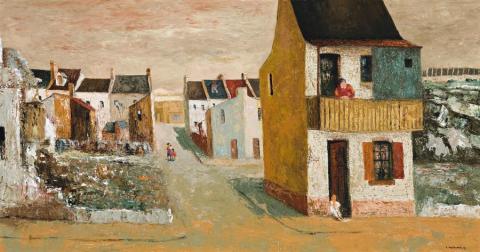TERRACE HOUSES, 1969
Sali Herman
oil on canvas
71.5 x 133.0 cm
signed and dated lower right: S. Herman, 69
Joseph Brown Gallery, Melbourne
Private collection, Melbourne
A passion for beautiful old Victorian houses has long been an established part of Australian urban culture. Built of stone or resplendent in patterned Hawthorn brick, these rows of terraces and grand single buildings richly decorated with intricate patterns of cast iron have graced the inner suburbs of Sydney and Melbourne since the mid-nineteenth century. They were not, however, always in favour. For a time they declined into a state of ruin and disrepair. Beginning in the 1940s, Sali Herman's streetscapes of Woolloomooloo, The Rocks and Paddington were part of the movement that led to their rediscovery, preservation and ultimate admiration. At first there was the painting McElhone Stairs, which was awarded the 1944 Wynne Prize. Not surprisingly, it was greeted with outrage. When the National Gallery of Victoria purchased Herman's The Law Courts 1946 through its Felton Bequest, the Railway Lunch 1948 went to the Bendigo Art Gallery via its Art Prize, and Near the Docks 1949 was acquired by the Art Gallery of New South Wales in that same year, the tide of opinion was moving in another direction. Herman's discovery of beauty where once only 'slumscapes' were seen changed our appreciation.1 Acceptance was complete. Herman went on win the Wynne Prize for landscape a further three times, plus the Sulman prize twice.
Herman was fascinated by the character of these buildings, their life within and around them. This he translated into art through his masterly sense of form, texture and colour, as seen so enticingly in Terrace Houses 1969. The isolation of the main building presents like a free-standing piece of sculpture.
Its striking angularity, crumbling surfaces and timbered balcony add to its visual appeal. In his exploration of the individual character of this and other similar buildings, Herman extends the pictorial narrative through the introduction of the people who inhabit them and their various activities. In our painting the passing scene is enjoyed by a woman on the balcony and a figure sitting on the front step, both participating in the entertainment of life outside their home. A family group walks into the distance further humanising the scene. Terrace Houses 1969 is more than a mere transcript of urban life and architecture of its time, for Herman has elevated it to a work of art, today its historical narrative giving it added/special appeal. The crumbling ruin to the left and the play of paint across a picture surface full of tactile delights adds liveliness to the painting, exuding that radiant joy which is the hallmark of Herman's best work.
1. Thomas, D., Sali Herman, William Collins (Australia) Ltd., Sydney 1971, p. 20
DAVID THOMAS
